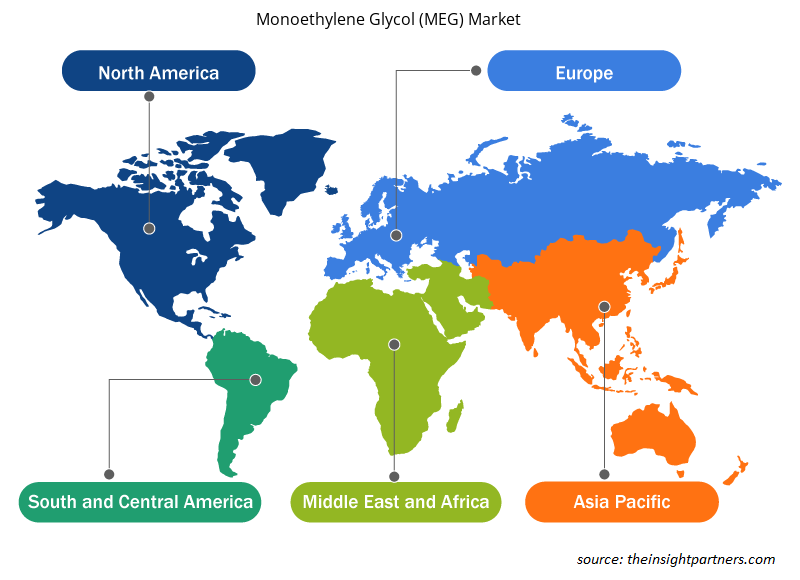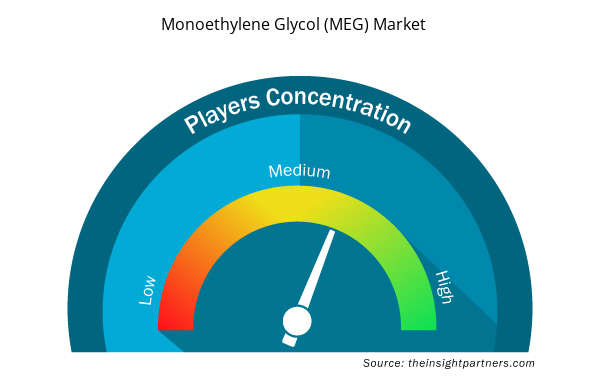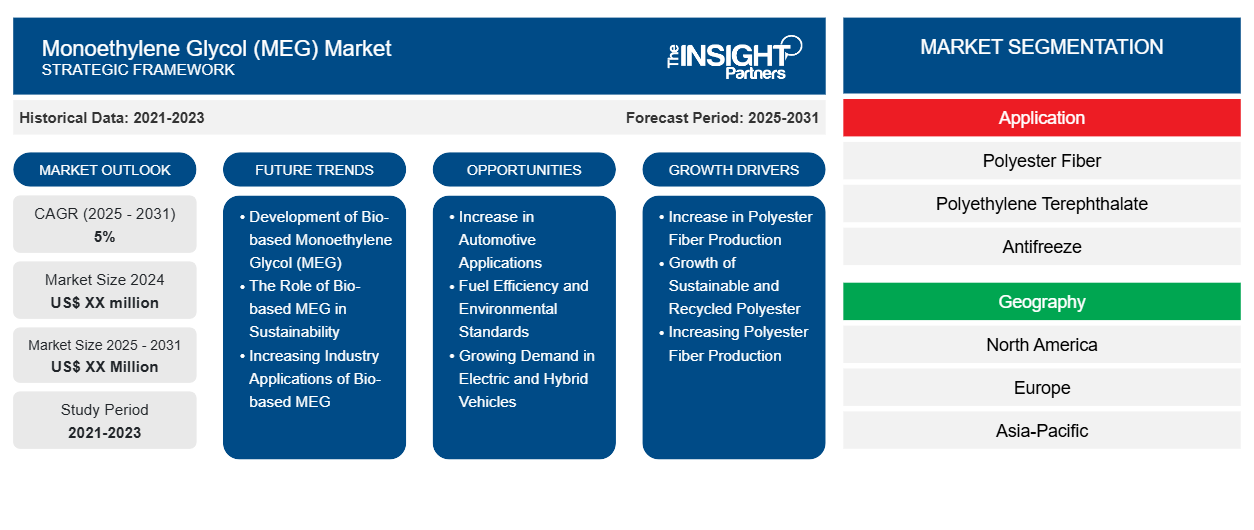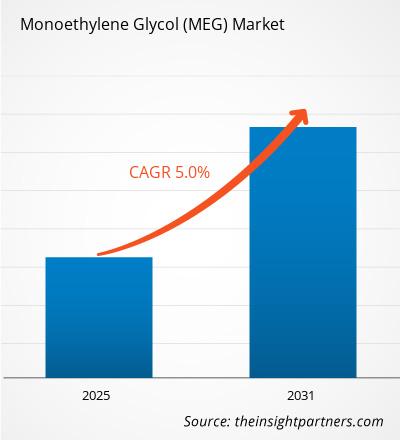Si prevede che il mercato del glicole monoetilenico (MEG) registrerà un CAGR del 5% dal 2024 al 2031, con una dimensione di mercato in espansione da XX milioni di dollari nel 2024 a XX milioni di dollari entro il 2031.
Il report è segmentato per applicazione (fibra di poliestere, polietilene tereftalato (PET), antigelo e altri). L'analisi globale è ulteriormente suddivisa a livello regionale e nei principali paesi. Il report offre il valore in USD per l'analisi e i segmenti di cui sopra.
Scopo del rapporto
Il report Monoethylene Glycol (MEG) Market di The Insight Partners mira a descrivere il panorama attuale e la crescita futura, i principali fattori trainanti, le sfide e le opportunità. Ciò fornirà spunti a vari stakeholder aziendali, come:
- Fornitori/produttori di tecnologia: per comprendere le dinamiche di mercato in evoluzione e conoscere le potenziali opportunità di crescita, consentendo loro di prendere decisioni strategiche informate.
- Investitori: condurre un'analisi completa delle tendenze in merito al tasso di crescita del mercato, alle proiezioni finanziarie del mercato e alle opportunità esistenti lungo la catena del valore.
- Enti di regolamentazione: regolamentano le politiche e le attività di controllo sul mercato allo scopo di ridurre al minimo gli abusi, preservare la fiducia degli investitori e sostenere l'integrità e la stabilità del mercato.
Segmentazione del mercato del glicole monoetilenico (MEG)
Applicazione
- Fibra di poliestere
- Polietilene tereftalato
- Antigelo
Personalizza questo report in base alle tue esigenze
Riceverai la personalizzazione gratuita di qualsiasi report, comprese parti di questo report, o analisi a livello nazionale, pacchetto dati Excel, oltre a usufruire di grandi offerte e sconti per start-up e università
- Scopri le principali tendenze di mercato in questo rapporto.Questo campione GRATUITO includerà analisi di dati che spaziano dalle tendenze di mercato alle stime e alle previsioni.
Fattori trainanti della crescita del mercato del glicole monoetilenico (MEG)
- Aumento della produzione di fibre di poliestere: un altro importante fattore di crescita del mercato del glicole monoetilenico è la produzione di fibre di poliestere. Il poliestere è uno dei prodotti tessili e di abbigliamento o di arredamento per la casa più ampiamente consumati; quindi, anche il MEG trarrà vantaggio dall'aumento della domanda di fibre di poliestere. L'industria tessile richiede fibre di poliestere per la loro resistenza, versatilità e basso costo. La sintesi del PET, il polimero principalmente utilizzato nella produzione di fibre di poliestere, richiederà quindi una chiave MEG. Ci si aspetta che l'aumento del livello di produzione per soddisfare la domanda dei consumatori si riversi nel corrispondente aumento della domanda di MEG.
- Crescita del poliestere sostenibile e riciclato: un altro motore del mercato MEG è la crescente popolarità del poliestere sostenibile e riciclato. Oggigiorno, sempre più aziende producono questo tipo di riciclabili, utilizzando PET riciclato, che necessita comunque di MEG per la sua lavorazione. Questo approccio, oltre a fornire il giusto tipo di supporto per l'iniziativa ambientale, sottolinea il ruolo che MEG ha svolto nell'economia circolare, ovvero la sua crescita di mercato.
- Aumento della produzione di fibre di poliestere: la produzione di fibre di poliestere può essere un forte motore di crescita nel mercato del glicole monoetilenico. Con l'aumento della produzione tessile e l'espansione dei processi di produzione, la domanda di MEG come materia prima importante continuerà ad aumentare, il che a sua volta offre notevoli opportunità per i produttori in questo settore.
Tendenze future del mercato del glicole monoetilenico (MEG)
- Sviluppo di glicole monoetilenico (MEG) di origine biologica: lo sviluppo di glicole monoetilenico di origine biologica è emerso come un importante motore di crescita nel mercato del glicole monoetilenico. Le industrie hanno recentemente mostrato maggiore interesse per la sostenibilità e, quindi, lo sviluppo di MEG di origine biologica da fonti rinnovabili sta emergendo come un'alternativa ecologica al MEG ampiamente utilizzato a base di petrolio, un prodotto molto attraente sia per i consumatori che per i produttori attenti all'ambiente.
- Il ruolo del MEG di origine biologica nella sostenibilità: il MEG di origine biologica si adatta bene a questo mondo sostenibile; i produttori sono desiderosi di ridurre l'impronta di carbonio della loro azienda. Il MEG di origine biologica contribuisce a rompere la dipendenza dai combustibili fossili, mentre viene sostenuto nel campo dell'economia circolare attraverso l'utilizzo di rifiuti e sottoprodotti agricoli. Sta già iniziando ad attrarre più investimenti e ricerche su questo fronte.
- Applicazioni industriali crescenti di MEG di origine biologica: il MEG di origine biologica è ampiamente utilizzato nelle formulazioni delle industrie tessili e degli imballaggi. Poiché sempre più consumatori sollevano preoccupazioni in merito alla sostenibilità dei prodotti offerti, i produttori stanno integrando materiali di origine biologica nelle loro linee di produzione per un migliore posizionamento sul mercato. Il MEG di origine biologica è utilizzato nella produzione di fibre di poliestere e PET. Pertanto, contribuisce in modo significativo alla produzione di tessuti e materiali di imballaggio ecocompatibili.
Opportunità di mercato del glicole monoetilenico (MEG)
- Aumento delle applicazioni automobilistiche: le applicazioni automobilistiche stanno fortemente guidando le opportunità di crescita nel mercato della monoetanolammina. MEA è utilizzato in diverse applicazioni di formulazione di automobili come additivi per carburante, refrigeranti per motori e agenti anticorrosione. Con il passare del tempo, a causa delle mutevoli esigenze dell'industria automobilistica, si prevede che sarà richiesta una maggiore domanda di prodotti chimici ad alte prestazioni, come MEA, e che il suo mercato ne verrà potenziato.
- Efficienza del carburante e standard ambientali: il requisito di efficienza del carburante e minori emissioni costringe il produttore a incorporare MEA nelle formulazioni del carburante. MEA fornisce una maggiore efficienza di combustione e riduce i depositi del motore, il che è fondamentale per far fronte a rigorosi standard ambientali. La domanda di MEA nelle applicazioni automobilistiche aumenterà poiché i produttori di automobili intendono migliorare le prestazioni dei veicoli riducendo al contempo i loro effetti negativi sull'ambiente.
- Domanda crescente di veicoli elettrici e ibridi: inoltre, i veicoli elettrici e le tecnologie ibride sono di crescente interesse. Viene utilizzato nella formulazione di fluidi di raffreddamento ed elettroliti per la batteria, un componente essenziale per il funzionamento efficiente dei veicoli elettrici. Poiché il mercato dei veicoli elettrici e ibridi continua a crescere, è probabile che i requisiti per prodotti chimici speciali come MEA aumentino.
Approfondimenti regionali sul mercato del glicole monoetilenico (MEG)
Le tendenze regionali e i fattori che influenzano il mercato del glicole monoetilenico (MEG) durante il periodo di previsione sono stati ampiamente spiegati dagli analisti di Insight Partners. Questa sezione discute anche i segmenti di mercato del glicole monoetilenico (MEG) e la geografia in Nord America, Europa, Asia Pacifico, Medio Oriente e Africa e America meridionale e centrale.

- Ottieni i dati specifici regionali per il mercato del glicole monoetilenico (MEG)
Ambito del rapporto di mercato del glicole monoetilenico (MEG)
| Attributo del report | Dettagli |
|---|---|
| Dimensioni del mercato nel 2024 | XX milioni di dollari USA |
| Dimensioni del mercato entro il 2031 | XX milioni di dollari USA |
| CAGR globale (2025 - 2031) | 5% |
| Dati storici | 2021-2023 |
| Periodo di previsione | 2025-2031 |
| Segmenti coperti | Per applicazione
|
| Regioni e Paesi coperti | America del Nord
|
| Leader di mercato e profili aziendali chiave |
|
Densità degli attori del mercato del glicole monoetilenico (MEG): comprendere il suo impatto sulle dinamiche aziendali
Il mercato del glicole monoetilenico (MEG) sta crescendo rapidamente, spinto dalla crescente domanda degli utenti finali dovuta a fattori quali l'evoluzione delle preferenze dei consumatori, i progressi tecnologici e una maggiore consapevolezza dei benefici del prodotto. Con l'aumento della domanda, le aziende stanno ampliando le loro offerte, innovando per soddisfare le esigenze dei consumatori e capitalizzando sulle tendenze emergenti, il che alimenta ulteriormente la crescita del mercato.
La densità degli operatori di mercato si riferisce alla distribuzione di aziende o società che operano in un particolare mercato o settore. Indica quanti concorrenti (operatori di mercato) sono presenti in un dato spazio di mercato in relazione alle sue dimensioni o al valore di mercato totale.
Le principali aziende che operano nel mercato del glicole monoetilenico (MEG) sono:
- LyondellBasell,
- La Dow Chemical Company,
- ME Global
- SABICO,
- Società ExxonMobil,
Disclaimer : le aziende elencate sopra non sono classificate secondo un ordine particolare.

- Ottieni una panoramica dei principali attori del mercato del glicole monoetilenico (MEG)
Punti chiave di vendita
- Copertura completa: il rapporto copre in modo completo l'analisi di prodotti, servizi, tipologie e utenti finali del mercato del glicole monoetilenico (MEG), fornendo una panoramica olistica.
- Analisi degli esperti: il rapporto è compilato sulla base della conoscenza approfondita di esperti e analisti del settore.
- Informazioni aggiornate: il rapporto garantisce la pertinenza aziendale grazie alla copertura di informazioni recenti e tendenze nei dati.
- Opzioni di personalizzazione: questo report può essere personalizzato per soddisfare le esigenze specifiche del cliente e adattarsi in modo appropriato alle strategie aziendali.
Il rapporto di ricerca sul mercato del glicole monoetilenico (MEG) può quindi aiutare a guidare il percorso di decodificazione e comprensione dello scenario del settore e delle prospettive di crescita. Sebbene possano esserci alcune preoccupazioni valide, i vantaggi complessivi di questo rapporto tendono a superare gli svantaggi.
- Analisi storica (2 anni), anno base, previsione (7 anni) con CAGR
- Analisi PEST e SWOT
- Valore/volume delle dimensioni del mercato - Globale, regionale, nazionale
- Industria e panorama competitivo
- Set di dati Excel



Report Coverage
Revenue forecast, Company Analysis, Industry landscape, Growth factors, and Trends

Segment Covered
This text is related
to segments covered.

Regional Scope
North America, Europe, Asia Pacific, Middle East & Africa, South & Central America

Country Scope
This text is related
to country scope.
Domande frequenti
Development of Bio-based Monoethylene Glycol (MEG) is expected to be the key market trends.
Based on geography, Asia Pacific held the largest share of the monoethylene glycol (MEG) market.
Based on application, polyester fiber is expected to witness the fastest growth during the forecast period
LyondellBasell, The Dow Chemical Company, SABIC are some of the key players operating in the monoethylene glycol (MEG) market
Increase in Polyester Fiber Production is driving the market growth
The Monoethylene Glycol (MEG) Market is estimated to witness a CAGR of 5% from 2023 to 2031
Trends and growth analysis reports related to Chemicals and Materials : READ MORE..
1. LyondellBasell,
2. The Dow Chemical Company,
3. ME Global
4. SABIC,
5. ExxonMobil Corporation,
6. NAN YA PLASTICS CORPORATION
7. Royal Dutch Shell,
8. Braskem,
9. Reliance Industries Limited,
10. BASF SE,
The Insight Partners performs research in 4 major stages: Data Collection & Secondary Research, Primary Research, Data Analysis and Data Triangulation & Final Review.
- Data Collection and Secondary Research:
As a market research and consulting firm operating from a decade, we have published and advised several client across the globe. First step for any study will start with an assessment of currently available data and insights from existing reports. Further, historical and current market information is collected from Investor Presentations, Annual Reports, SEC Filings, etc., and other information related to company’s performance and market positioning are gathered from Paid Databases (Factiva, Hoovers, and Reuters) and various other publications available in public domain.
Several associations trade associates, technical forums, institutes, societies and organization are accessed to gain technical as well as market related insights through their publications such as research papers, blogs and press releases related to the studies are referred to get cues about the market. Further, white papers, journals, magazines, and other news articles published in last 3 years are scrutinized and analyzed to understand the current market trends.
- Primary Research:
The primarily interview analysis comprise of data obtained from industry participants interview and answers to survey questions gathered by in-house primary team.
For primary research, interviews are conducted with industry experts/CEOs/Marketing Managers/VPs/Subject Matter Experts from both demand and supply side to get a 360-degree view of the market. The primary team conducts several interviews based on the complexity of the markets to understand the various market trends and dynamics which makes research more credible and precise.
A typical research interview fulfils the following functions:
- Provides first-hand information on the market size, market trends, growth trends, competitive landscape, and outlook
- Validates and strengthens in-house secondary research findings
- Develops the analysis team’s expertise and market understanding
Primary research involves email interactions and telephone interviews for each market, category, segment, and sub-segment across geographies. The participants who typically take part in such a process include, but are not limited to:
- Industry participants: VPs, business development managers, market intelligence managers and national sales managers
- Outside experts: Valuation experts, research analysts and key opinion leaders specializing in the electronics and semiconductor industry.
Below is the breakup of our primary respondents by company, designation, and region:

Once we receive the confirmation from primary research sources or primary respondents, we finalize the base year market estimation and forecast the data as per the macroeconomic and microeconomic factors assessed during data collection.
- Data Analysis:
Once data is validated through both secondary as well as primary respondents, we finalize the market estimations by hypothesis formulation and factor analysis at regional and country level.
- Macro-Economic Factor Analysis:
We analyse macroeconomic indicators such the gross domestic product (GDP), increase in the demand for goods and services across industries, technological advancement, regional economic growth, governmental policies, the influence of COVID-19, PEST analysis, and other aspects. This analysis aids in setting benchmarks for various nations/regions and approximating market splits. Additionally, the general trend of the aforementioned components aid in determining the market's development possibilities.
- Country Level Data:
Various factors that are especially aligned to the country are taken into account to determine the market size for a certain area and country, including the presence of vendors, such as headquarters and offices, the country's GDP, demand patterns, and industry growth. To comprehend the market dynamics for the nation, a number of growth variables, inhibitors, application areas, and current market trends are researched. The aforementioned elements aid in determining the country's overall market's growth potential.
- Company Profile:
The “Table of Contents” is formulated by listing and analyzing more than 25 - 30 companies operating in the market ecosystem across geographies. However, we profile only 10 companies as a standard practice in our syndicate reports. These 10 companies comprise leading, emerging, and regional players. Nonetheless, our analysis is not restricted to the 10 listed companies, we also analyze other companies present in the market to develop a holistic view and understand the prevailing trends. The “Company Profiles” section in the report covers key facts, business description, products & services, financial information, SWOT analysis, and key developments. The financial information presented is extracted from the annual reports and official documents of the publicly listed companies. Upon collecting the information for the sections of respective companies, we verify them via various primary sources and then compile the data in respective company profiles. The company level information helps us in deriving the base number as well as in forecasting the market size.
- Developing Base Number:
Aggregation of sales statistics (2020-2022) and macro-economic factor, and other secondary and primary research insights are utilized to arrive at base number and related market shares for 2022. The data gaps are identified in this step and relevant market data is analyzed, collected from paid primary interviews or databases. On finalizing the base year market size, forecasts are developed on the basis of macro-economic, industry and market growth factors and company level analysis.
- Data Triangulation and Final Review:
The market findings and base year market size calculations are validated from supply as well as demand side. Demand side validations are based on macro-economic factor analysis and benchmarks for respective regions and countries. In case of supply side validations, revenues of major companies are estimated (in case not available) based on industry benchmark, approximate number of employees, product portfolio, and primary interviews revenues are gathered. Further revenue from target product/service segment is assessed to avoid overshooting of market statistics. In case of heavy deviations between supply and demand side values, all thes steps are repeated to achieve synchronization.
We follow an iterative model, wherein we share our research findings with Subject Matter Experts (SME’s) and Key Opinion Leaders (KOLs) until consensus view of the market is not formulated – this model negates any drastic deviation in the opinions of experts. Only validated and universally acceptable research findings are quoted in our reports.
We have important check points that we use to validate our research findings – which we call – data triangulation, where we validate the information, we generate from secondary sources with primary interviews and then we re-validate with our internal data bases and Subject matter experts. This comprehensive model enables us to deliver high quality, reliable data in shortest possible time.


 Ottieni un campione gratuito per questo repot
Ottieni un campione gratuito per questo repot